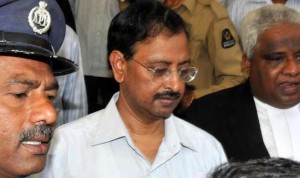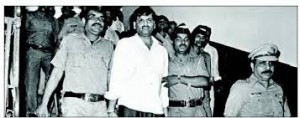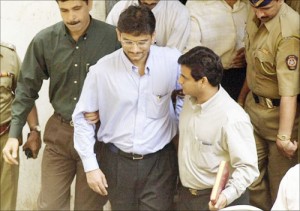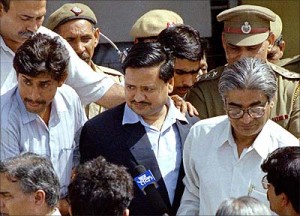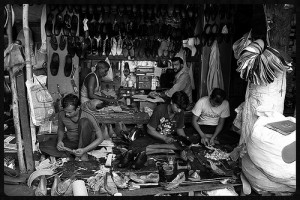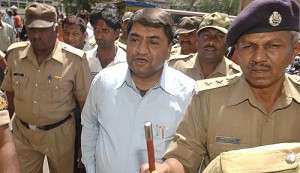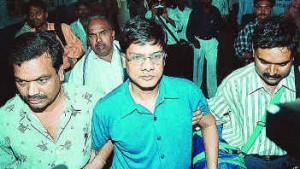India has seen some of the most high-profile scandals where investors have lost billions of rupees just because a few people in high places could not control their greed.
Ramalinga Raju
- The biggest corporate scam in India has come from one of the most respected businessmen.
- Satyam founder Ramalinga Raju resigned as its chairman after admitting to cooking up the account books.
- His efforts to fill the “fictitious assets with real ones” through Maytas acquisition failed, after which he decided to confess the crime.
- With a fraud involving about Rs 8,000 crore (Rs 80 billion), Satyam is heading for more trouble in the days ahead.
Harshad Mehta
- He was known as the ‘Big Bull’. However, his bull run did not last too long.
- He triggered a rise in the Bombay Stock Exchange in the year 1992 by trading in shares at a premium across many segments.
- Taking advantages of the loopholes in the banking system, Harshad and his associates triggered a securities scam diverting funds to the tune of Rs 4000 crore (Rs 40 billion) from the banks to stockbrokers between April 1991 to May 1992.
Ketan Parekh
- Ketan Parekh followed Harshad Mehta’s footsteps to swindle crores of rupees from banks. A chartered accountant he used to run a family business, NH Securities. Ketan however had bigger plans in mind. He targeted smaller exchanges like the Allahabad Stock Exchange and the Calcutta Stock Exchange, and bought shares in fictitious names.
- His dealings revolved around shares of ten companies like Himachal Futuristic, Global Tele-Systems, SSI Ltd, DSQ Software, Zee Telefilms, Silverline, Pentamedia Graphics and Satyam Computer (K-10 scrips).
- Ketan borrowed Rs 250 crore from Global Trust Bank to fuel his ambitions. Ketan along with his associates also managed to get Rs 1,000 crore from the Madhavpura Mercantile Co-operative Bank.
- According to RBI regulations, a broker is allowed a loan of only Rs 15 crore (Rs 150 million). There was evidence of price rigging in the scrips of Global Trust Bank, Zee Telefilms, HFCL, Lupin Laboratories, Aftek Infosys and Padmini Polymer.
C R Bhansali
- The Bhansali scam resulted in a loss of over Rs 1,200 crore (Rs 12 billion).
- He first launched the finance company CRB Capital Markets, followed by CRB Mutual Fund and CRB Share Custodial Services. He ruled like financial wizard 1992 to 1996 collecting money from the public through fixed deposits, bonds and debentures. The money was transferred to companies that never existed.
- CRB Capital Markets raised a whopping Rs 176 crore in three years. In 1994 CRB Mutual Funds raised Rs 230 crore and Rs 180 crore came via fixed deposits. Bhansali also succeeded to to raise about Rs 900 crore from the markets.
- However, his good days did not last long, after 1995 he received several jolts. Bhansali tried borrowing more money from the market. This led to a financial crisis.
Cobbler scam
- Sohin Daya, son of a former Sheriff of Mumbai, was the main accused in the multi-crore shoes scam. Daya of Dawood Shoes, Rafique Tejani of Metro Shoes, and Kishore Signapurkar of Milano Shoes were arrested for creating several leather co-operative societies which did not exist.
- They availed loans of crores of rupees on behalf of these fictitious societies. The scam was exposed in 1995. The accused created a fictitious cooperative society of cobblers to take advantage of government loans through various schemes.
- Officials of the Maharashtra State Finance Corporation, Citibank, Bank of Oman, Dena Bank, Development Credit Bank, Saraswat Co-operative Bank, and Bank of Bahrain and Kuwait were also charge sheeted.
IPO Scam
- The Securities and Exchange Board of India barred 24 key operators, including Indiabulls and Karvy Stock Broking, from operating in the stock market and banned 12 depository participants from opening fresh accounts for their involvement in the Initial Public Offer scam.
- It also banned 85 financiers from capital market activities.
- Suzlon Energy Ltd’s Rs 1,496.34 crore (Rs 14.963 billion) public issue (September 23-29, 2005). The retail portion was oversubscribed 6.04 times and the non-institutional portion was oversubscribed 40.27 times. Key operators used 21,692 fictitious accounts to corner 323,023 shares representing 3.74 per cent of the total number of shares allotted to retail individual investors.
- Jet Airways’s Rs 1,899.3 crore (Rs 18.993 billion) public offer (Feb 18-24, 2005). The retail portion was subscribed 2.99 times and the non-institutional portion by 12.5 times. Key operators used 1186 fake accounts for cornering 20,901 shares representing 0.52 per cent of the total number of shares allotted to retail investors.
- National Thermal Power Corporation Ltd’s Rs 5,368.14 crore (Rs 53.681 billion) IPO (Oct 7-14, 2004). The retail portion was oversubscribed 3.73 times and the non-institutional portion by 11.93 times. Key operators used a total of 12,853 afferent accounts for cornering 2,750,730 shares representing 1.3 per cent of the total number of shares allotted to retail investors.
- Tata Consultancy Services’s Rs 4,713.47 crore (Rs 47.134 billion) public offer (Aug 19-23, 2004). The retail portion was oversubscribed 2.86 times and the non-institutional portion by 19.15 times. Key operators used 14,619 ‘benami’ accounts to corner 261,294 shares representing 2.09 per cent of the total shares allotted to retail individual investors.
- Patni Computer System Ltd’s Rs 430.65 crore (Rs 4.306 billion) public issue (Jan 27-Feb 5 2004). The retail portion was oversubscribed 9.36 times and the non-institutional portion by 39.22 times. A lone key operator used 2541 afferent account for cornering 127,050 shares representing 2.71 per cent of the total number of shares allotted to retail investors.
Dinesh Dalmia
- Dinesh Dalmia was the managing director of DSQ Software Limited when the Central Bureau of Investigation arrested him for his involvement in a stocks scam of Rs 595 crore (Rs 5.95 billion).
- Dalmia’s group included DSQ Holdings Ltd, Hulda Properties and Trades Ltd, and Powerflow Holding and Trading Pvt Ltd.
- Dalmia resorted to illegal ways to make money through the partly paid shares of DSQ Software Ltd, in the name of New Vision Investment Ltd, UK, and unallotted shares in the name of Dinesh Dalmia Technology Trust.
- Investigation showed that 1.30 crore (13 million) shares of DSQ Software Ltd had not been listed on any stock exchange.
Abdul Karim Telgi
- He paid for his own education at Sarvodaya Vidyalaya by selling fruits and vegetables on trains.
- He is today famous (or infamous) for being the man behind one of India’s biggest scams.
- The Telgi case is another big scam that rocked India. The fake stamp racket involving Abdul Karim Telgi was exposed in 2000. The loss is estimated to be Rs 171.33 crore (Rs 1.71 billion), it was initially pegged to be Rs 30,000 crore (Rs 300 bilion), which was later clarified by the CBI as an exaggerated figure.
- In 1994, Abdul Karim Telgi acquired a stamp paper license from the Indian government and began printing fake stamp papers.
- Telgi bribed to get into the government security press in Nashik and bought special machines to print fake stamp papers.
- Telgi’s networked spread across 13 states involving 176 offices, 1,000 employees and 123 bank accounts in 18 cities.
Virendra Rastogi
- Virendra Rastogi chief executive of RBG Resources was charged with for deceiving banks worldwide of an estimated $1 billion.
- He was also involved in the duty-drawback scam to the tune of Rs 43 crore (Rs 430 milion) in India.
- The CBI said that five companies, whose directors were the four Rastogi brothers — Subash, Virender, Ravinde and Narinder — exported bicycle parts during 1995-96 to Russia and Hong Kong by heavily over invoicing the value of goods for claiming excess duty draw back from customs.
The UTI Scam
- Former UTI chairman P S Subramanyam and two executive directors — M M Kapur and S K Basu — and a stockbroker Rakesh G Mehta, were arrested in connection with the ‘UTI scam’.
- UTI had purchased 40,000 shares of Cyberspace between September 25, 2000, and September 25, 2000 for about Rs 3.33 crore (Rs 33.3 million) from Rakesh Mehta when there were no buyers for the scrip. The market price was around Rs 830.
- The CBI said it was the conspiracy of these four people which resulted in the loss of Rs 32 crore (Rs 320 million). Subramanyam, Kapur and Basu had changed their stance on an investment advice of the equities research cell of UTI.
- The promoter of Cyberspace Infosys, Arvind Johari was arrested in connection with the case. The officals were paid Rs 50 lakh (Rs 5 million) by Cyberspace to promote its shares.
- He also received Rs 1.18 crore (Rs 11.8 million) from the company through a circuitous route for possible rigging the Cyberspace counter.
Sanjay Agarwal
- Home Trade had created waves with celebrity endorsements.
- But Sanjay Agarwal’s finance portal was just a veil to cover up his shady deals. He swindled a whopping Rs 600 crore (Rs 6 billion) from more than 25 cooperative banks.
- The government securities (gilt) scam of 2001 was exposed when the Reserve Bank of India checked the acounts of some cooperative banks following unusual activities in the gilt market.
- Co-operative banks and brokers acted in collusion in abid to make easy money at the cost of the hard earned savings of millions of Indians. In this case, even the Public Provident Fund (PPF) was affected.
- A sum of about Rs 92 crore (Rs 920 million) was missing from the Seamen’s Provident Fund. Sanjay Agarwal, Ketan Sheth (a broker), Nandkishore Trivedi and Baluchan Rai (a Hong Kong-based Non-Resident Indian) were behind the Home Trade scam.
